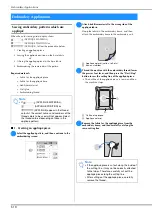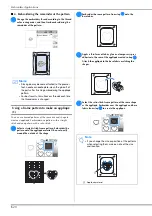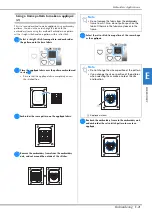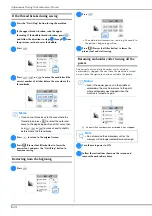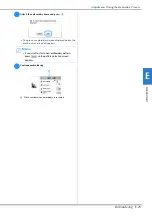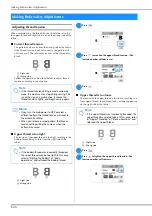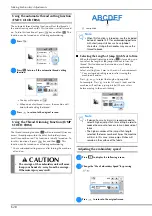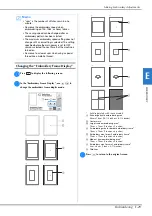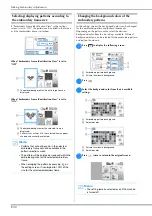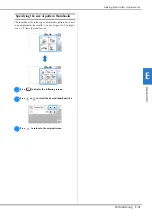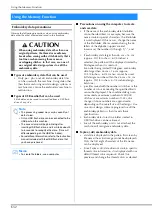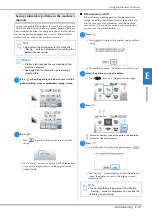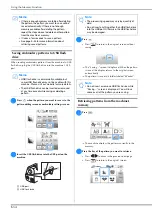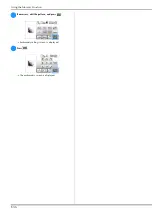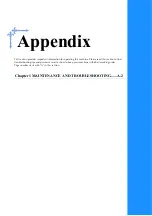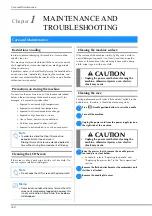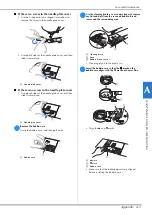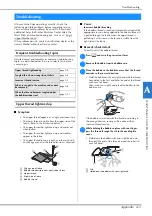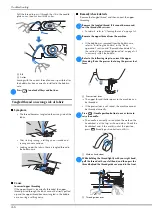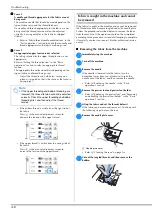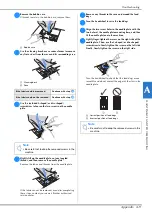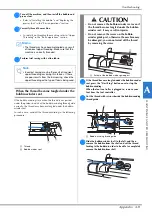
Using the Memory Function
E-32
Embroidery data precautions
Observe the following precautions when using embroidery
data other than that created and saved in this machine.
■
Types of embroidery data that can be used
• Only .pes, .phc, and .dst embroidery data files
can be used with this machine. Using data other
than that saved using our data design systems or
machines may cause the embroidery machine to
malfunction.
■
Types of USB media that can be used
Stitch data can be saved to or recalled from a USB flash
drive of any size.
■
Precautions on using the computer to create
and save data
• If the name of the embroidery data file/folder
cannot be identified, for example, because the
name contains special characters, the file/folder
is not displayed. If this occurs, change the name
of the file/folder. We recommend using the 26
letters of the alphabet (uppercase and
lowercase), the numbers 0 through 9,”-”, and
“_”.
• If embroidery data larger than 26 cm × 16 cm
(approx. 10-1/4 inches × 6-1/4 inches) is
selected, the pattern will be displayed rotated by
90 degrees when it is read out.
Even after being rotated 90 degrees, embroidery
data larger than 26 cm
16 cm (approx.
10-1/4 inches
6-1/4 inches) cannot be used.
(All designs must be within the 26 cm
16 cm
(approx. 10-1/4 inches
6-1/4 inches) design
field size.)
• .pes files saved with the number of stitches or the
number of colors exceeding the specified limits
cannot be displayed. The combined design can
not exceed a maximum number of 200,000
stitches or a maximum number of 125 color
changes (Above numbers are approximate,
depending on the overall size of the design). Use
one of our design software programs to edit the
embroidery pattern so that it meets these
specifications.
• Embroidery data stored in a folder created in
USB flash drive can be retrieved.
• Even if the embroidery unit is not attached, the
machine will recognize embroidery data.
■
Tajima (.dst) embroidery data
• .dst data is displayed in the pattern list screen by
file name (the actual image cannot be displayed).
Only the first eight characters of the file name
can be displayed.
• Since Tajima (.dst) data does not contain specific
thread color information, it is displayed with our
default thread color sequence. Check the
preview and change the thread colors as desired.
Using the Memory Function
CAUTION
• When using embroidery data other than our
original patterns, the thread or needle may
break when sewing with a stitch density that is
too fine or when sewing three or more
overlapping stitches. In that case, use one of
our original data design systems to edit the
embroidery data.
Note
• The processing speed may vary by quantity of
data stored.
• Only a USB flash drive can be connected to the
USB port on this machine.
• The access lamp will begin blinking after
inserting USB flash drive, and it will take about 5
to 6 seconds to recognize the drive. (Time will
differ depending on the USB flash drive).
• For additional information, refer to the instruction
manual included with the USB flash drive that
you have purchased.
Memo
• To create file folders, use a computer.
Summary of Contents for 888-G10
Page 2: ......
Page 76: ...Embroidering B 66 ...
Page 122: ...Decorative Stitching S 46 ...
Page 208: ......
Page 209: ......
Page 210: ......
Page 211: ......

